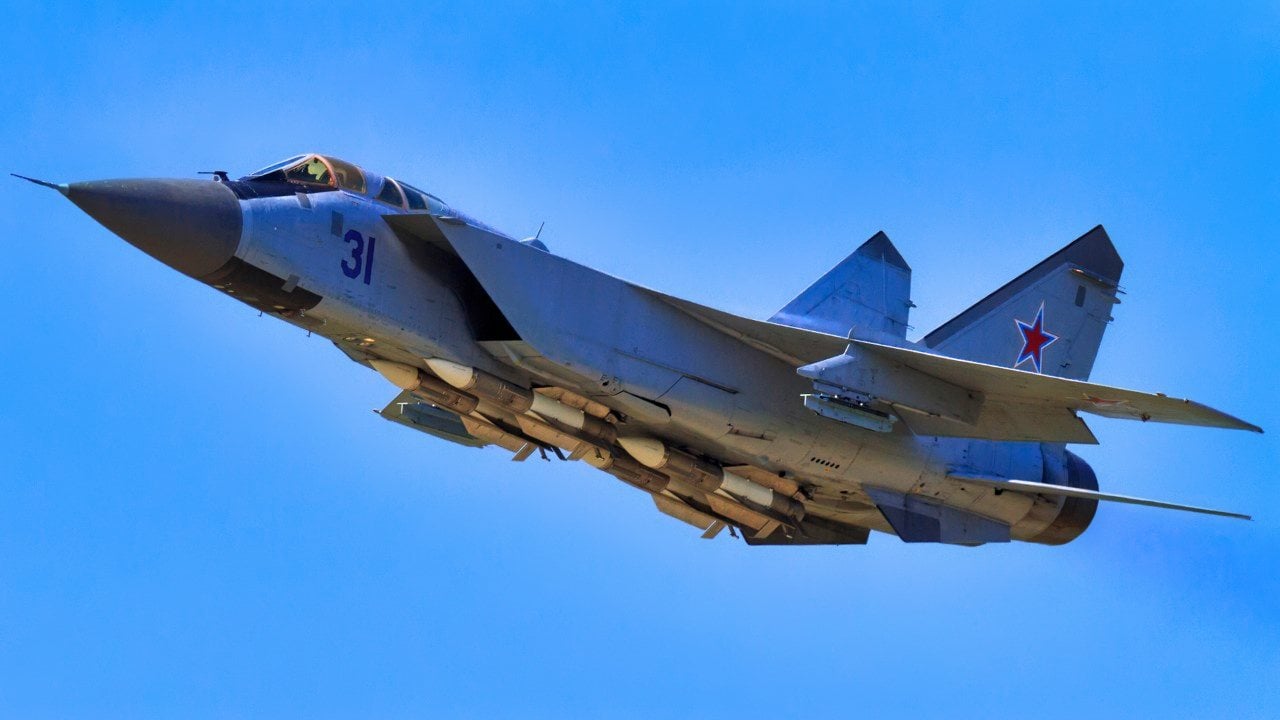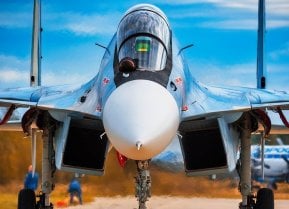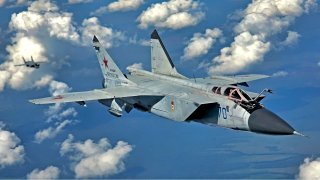Russia's MiG-31: Hypersonic Missile Truck or Obsolete?
The MiG-31 has thus served as a terror weapon that can disrupt daily life in Ukraine. And it could become a hypersonic missile 'truck' in the sky.
The MiG-31 is Still a Capable Combat Aircraft - Even as the Kremlin has been seen more as a paper tiger than a truly fearsome bear after it failed to achieve a quick victory in Ukraine, it still fields some impressive combat platforms. Among those is the Mikoyan MiG-31 (NATO reporting name "Foxhound"), a warplane that was developed during the Cold War era as a home defense interceptor
The long-range, two-seat supersonic aircraft has maintained a certain mystique in the West, in part because there remains much speculation over all of its capabilities. It took its maiden flight in September 1975 and was designed to work efficiently in all weather conditions.
However, it hasn't served as an interceptor in Ukraine – rather it has proven to be a capable attack aircraft that Kyiv takes very seriously, and with good reason. The supersonic fighter is capable of carrying Kinzhal ballistic missiles. Because those missiles travel at very high speeds and have a long-range, every time a MiG-31 takes off from a Russian military base near Ukraine, an air raid alert is issued across the entire country, sometimes lasting for hours.
The MiG-31 has thus served as a terror weapon that can disrupt daily life in Ukraine.
As the Kyiv Post recently reported, "A lot of businesses in Ukraine have a safety policy of closing during air raid alerts so the warnings triggered by MiG-31s are highly disruptive to the Ukrainian economy. Russia has learned that it can shut down a large chunk of Ukrainian business simply by putting one MiG-31 in the air and leaving it to fly around for a while."
Capable Warbird
Derived from the MiG-25 Foxbat interceptor and equipped with state-of-the-art digital avionics. Unlike the MiG-25, it has two seats, with the rear occupied by a dedicated weapon systems officer.
The long-range supersonic aircraft has maintained a certain mystique in the west, in part because there remains much speculation over all of its capabilities. Its reported airframe comprises 49 percent arc-welded nickel steel, 33 percent light metal alloy, 16 percent titanium, and two percent composites.
The MiG-31 also was designed to work efficiently in all weather conditions, while its highly aerodynamic and streamlined body enabled it to fly at low altitudes with required supersonic speeds. It is equipped with efficient low-bypass-ratio turbofan engines, which allow an increase in combat range.
Though the MiG-31 was not developed for close combat or rapid turning, it was the first soviet fighter aircraft to have true look-down and shoot-down capability, while it could track multiple targets simultaneously at high altitudes.
In fact, the MiG-31's Zaslon radar was the world's first phased-array unit, which had a range of 200 km. It could track 10 targets simultaneously, and control the engagement of 4 of them at once. Until 2001 – when the Japanese Mitsubishi F-2 with an advanced phased-array radar was adopted – the MiG-31 was the world's only serial fighter aircraft to be equipped with such a phased-array radar.
There have been rumors that during the late Cold War, a MiG-31 Foxhound may have been used to chase after the U.S. military's SR-71 Blackbird spy plane and reportedly locked on with its missiles, but as the American reconnaissance aircraft was never employed to actually overfly Soviet airspace. Whether the incidence occurred has remained a matter of conjecture at best.
Still in Service
The MiG-31 took its maiden flight in September 1975 and production of the aircraft began in 1979, while it formally entered service in 1982.
The MiG-31 was never exported by the Soviet Union, and a total of 519 were produced. Most have remained in service with the Russian Air Force, while some thirty are reported to be operated by the Kazakhstan Air Force.
However, Syria had reportedly ordered eight of the MiG-31E aircraft in 2007, while the order was suspended due to Israeli pressure along with a lack of Syrian funds. More recently, Turkish news media has reported that six of the aircraft may have been delivered for use by the Syrian Arab Air Force, but Russia has denied that it actually sold the aircraft to Syria.
Old MiG-31 Foxhound, New Tricks
It was reported in 2021 that the Russian military had completed the most recent upgrades to the MiG-31, while the Kremlin explored the option of arming the home-defense interceptor with hypersonic missiles, which would make the airframe a very serious threat.
Despite the fact that the aircraft dates back to the 1970s, Russia has an established trend of preserving original aircraft designs by integrating modern weapons and avionics and this has resulted in the MiG-31BM upgrade from a decade ago. The upgrades provided network-centric combat control, as well as phased array radar.

The upgraded MiG-31BM can also employ R-33 long-range air-to-air missiles and R-73 short-range air-launched weapons. It is powered by two D-30F6 engines, which provide a take-off thrust of 15,500 kgf each, and the fighter interceptor has a maximum speed of 3,000 km/h and a ceiling of 20,600 meters. It is also outfitted with a mid-air refueling system. It is unknown how many of the original MiG-31s have been upgraded to the 31BM standard, but it has been reported that it is less than 100 of the original 500 aircraft produced during the Soviet era.
The Russian Defense Ministry expects the MiG-31 to remain in service until 2030 or beyond.
Author Experience and Expertise
Peter Suciu is a Michigan-based writer. He has contributed to more than four dozen magazines, newspapers, and websites with over 3,200 published pieces over a twenty-year career in journalism. He regularly writes about military hardware, firearms history, cybersecurity, politics, and international affairs. Peter is also a Contributing Writer for Forbes and Clearance Jobs. You can follow him on Twitter: @PeterSuciu.
Image Credit: Creative Commons.


